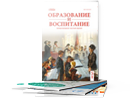This article is devoted to the study of the numbers in Latin. In particular, the article contains clear information about grammatical types of the numbers in Latin. The study used materials from social networks and a textbook.
Keywords: Italic language, compound numbers, octo, word order.
Latin (lingua Latina, sermo Latinus) is an Italic language that was spoken in Latium and Ancient Rome from the second millennium BC to the second millennium AD, and subsequently continued into the Middle Ages. Latin is remains one of Vatican City's co-official languages, despite the fact that it has no local speakers (alongside with French, German and Italian).
I [1], V [5], X [10], L [50], C [100], D [500], and M [1,000] are all Roman numbers made up of seven letters or symbols. They were used in ancient Rome and the Middle Ages to count up to 4,999 using a combination of additive and subtractive methods. To make a number, add the symbols from left to right until we get three identical symbols (this is the additive part: I, II, III, XXII), then set the number to remove on the left side of the greater symbol (this is the subtractive part: IV, IX, XC). Except for M, you can't use the same symbol more than three times in a row (MMMM is 4,000). It is an additive system, unlike the decimal system, in which each symbol has its own value regardless of its location.
A number written in Roman characters must comply with the following standards in order to be considered valid:
– A maximum of three times the Roman digits can be repeated (VIII is valid, but VIIII is not)
– Only one repetition of the integers D, L, and V is possible (DD, LL and VV are not valid)
– Only one C can be inserted before a M (CM, or 900) or a D (CD, or 400) and the subsequent values cannot be larger than 99. (or we would jump to the next hundred)
– Only one X can be placed in front of a C (XC, or 90) or a L (XXC, or 90, is legal, but XXC is not) (XL, ou 40, is valid, XXL is not) & none of the following numbers can exceed nine (or we would jump to the next ten)
– Only one I or a V can come before an X (IX, or 9, is legal, but IIX is not) (IV, ou 4, is valid, IIV is not)
Latin numbering rules
Let's move on to the writing rules for the tens, compound numbers, and, why not, the hundreds, thousands, and beyond now that you've gotten a handle on the most useful numbers (if possible):
– Nulla [0], unus/una/unum (m/f/n) [1], duo/duae/duo (m/f/n) [2], tres/tres/tria (m/f/n) [3], quattuor [4], quinque [5], sex [6], septem [7], octo [8, novem [9], and decem [10] are particular terms.
– Undecim [11], duodecim [12], tredecim [13], quattuordecim [14], quindecim [15], sedecim [16], and septendecim [17] are the numbers generated from the root of the digit followed by ten. Duodeviginti [18] (literally two from twenty) and undeviginti [19] are generated by subtracting (one from twenty).
The use of Latin numerals:
– Now that you've mastered the most useful numbers, let's move on to the rules for writing tens, compound numbers, and, why not, hundreds, thousands, and beyond (if possible).
– Particular terms include nulla [0], unus/una/unum (m/f/n) [1], duo/duae/duo (m/f/n) [2, tres/tres/tria (m/f/n) [3, quattuor [4], quinque [5], sex [6, septem [7], octo [8, novem [9], and decem [10].
– The numbers created from the root of the digit followed by ten are known as undecim [11], duodecim [12], tredecim [13], quattuordecim [14], quindecim [15], sedecim [16], and septendecim [17]. By subtracting two from twenty, duodeviginti [18] and undeviginti [19] are produced (one from twenty).
Numbers in sentences
The use of numbers in sentences is quite similar to the use of adjectives in sentences. The only difference is that most numbers have only one globally accepted form. The following is perhaps the only serious difficulty that could arise:
Ambulant pueri octo canes
Latin has a fairly free word order in terms of grammatical structure. It may be difficult to determine which noun a number belongs to because certain numbers only have one form. For example, does «octo» refer to the number of boys or dogs? Adjectives are normally placed after their corresponding nouns in the Latin Dictionary, therefore in this example, we have eight guys strolling some dogs. However, because Latin poets and other texts do not always follow this rule, the statement may become confusing, particularly if extra words are added.
Translate some of the following sentences:
|
Sentence |
Translation |
|
The boy has two dreams. |
Puer somnia duo habet. |
|
The woman prepares the four girls. |
Femina puellas quattuor parat. |
|
The good man gives his one shoe. |
Vir bonus calceum unum suum dat. |
|
I am one man. |
Vir unus sum. |
|
The six small girls have good form. |
Puellae parvae sex formam bonam habent. |
|
The old man fears the ten angry boys. |
Vir antiquus pueros iratos decem timet. |
In conclusion the article looked at numbers in the Latin language. Numbers follow and change according to a variety of rules. Furthermore, in terms of grammatical structure, Latin allows for a lot of flexibility in word order. Because some numbers only have one form, it can be difficult to figure out which word they belong to.
References:
- Latin terminology in medicine: reference.- study. Stipend/Petrova V. G., V. I. Ermicheva. — 2nd edition, ispr. and add. — M: Astrel, AST, 2009, pp. 1–9
- The Latin language and the basics of medical terminology: textbook., A. Z. Tsisyk, E. S. Shvayko, — M.: Medicine, 2009, pp. 9–10.
- Stroh, W. O Latinitas! Erfahrungen mit lebendigem Latein und ein Rьckblick auf zehn Jahre Sodalitas / W. Stroh // Gymnasium. — 1997. — 104. — P. 271–290.
- Burke, P. Heu domine, adsunt Turcae! AbriЯ einer Sozialgeschichte des postmittelalterlichen Lateins / P.Burke // Verf., Kchenlatein. — 1989. — S. 31–59.
- Europas Muttersprachen: Latein und Altgriechisch sind in Deutschland wieder im Kommen // Die Welt Online [Electronic resource],-07.04.2006. Mode of access: article209136/Europas_Muttersprachen.html. http://www.welt.de/print-welt/
- Landfester, M. Humanismus und Gesellschaft im 19. Jahrhundert / M. Landfester. — Wiss. Buchgesellschaft, 1988. — 225 S.
- URL: www.pedagogica.ru
- Borovskij, Ja. M. Latinskij jazyk kak mezhdunarodnyj jazyk nauki // Problemy mezhdunarodnogo vspomogatel'nogo jazyka. M., 2001. 120 s.
- Chernyavskij M. N. Latinskij yazyk i osnovy medicinskoj terminologii: Uchebnik. Moskva: Medicina, 2002.
- Boldyreva O. N. Net puti v medicine bez latinskogo yazyka (Non est viainmedicina sine lingua Latina). Available at: https://www.informio.ru/publications/id3039/Net-puti-v-medicinebez-latinskogo-jazyka-Non-est-via-in-medicina-sine-lingua-Latina.
- Vasil’eva L. I. Posobie po latinskomu yazyku. Klinicheskaya terminologiya: Ucheb. posobie. Minsk: IKO «Galaksias», 1997.
- Zarnigor Obidovna Djalilova Studies on gender linguistics in the field of Uzbek language // Academic research in educational sciences. 2021. № 3. URL: https://cyberleninka.ru/article/n/studies-on-gender-linguistics-in-the-field-of-uzbek-language (дата обращения: 15.12.2021).
- Djalilova Zarnigor Obidovna. (2021). Comparative Analysis Of Uzbek Men’s And Women’s Speech Through The Prism Of Gender Linguistics. Central Asian Journal of Literature, Philosophy and Culture, 2(2), 22–26. https://doi.org/10.47494/cajlpc.v2i2.65
- Djalilova Zarnigor Obidovna, & Sadullaev Denis. (2021). Formulas of speech etiquette in a gender-engineered communication strategy. Central Asian Journal of Theoretical & Applied Sciences, 2(6), 5–11. Retrieved from http://cajotas.centralasianstudies.org/index.php/CAJOTAS/article/view/180







